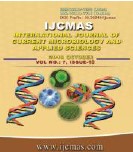


 National Academy of Agricultural Sciences (NAAS)
National Academy of Agricultural Sciences (NAAS)

|
PRINT ISSN : 2319-7692
Online ISSN : 2319-7706 Issues : 12 per year Publisher : Excellent Publishers Email : editorijcmas@gmail.com / submit@ijcmas.com Editor-in-chief: Dr.M.Prakash Index Copernicus ICV 2018: 95.39 NAAS RATING 2020: 5.38 |
Cooking and eating quality of rice is predominantly influenced by various physio-chemical characteristics of starch. This study was aimed to characterize the physio-chemical properties of starch in commercially and traditionally cultivated rice varieties using Rapid Viscosity Analyser (RVA) in relation to identify the genotype with prominent starch composition to maximize the consumer’s acceptability. Initially a study conducted to determine the amylose content variations among the selected genotypes and measurement on RVA parameters had a significant difference among the varieties. The polished rice flour showed higher range of peak viscosity, hold viscosity, breakdown viscosity, final viscosity and setback viscosity than brown rice flour. It clearly indicated that the step of polishing had a major influence on the pasting curve. In addition, pigmented rice cultivars had variation among the pasting profile due to the effect of colour parameter. It was found that brown rice exhibited intermediate to high amylose content and rangedfrom18.45 % to 25.97 % whereas the polished rice varied between 17.84 % and 23.19 % with the mean value of 22.39 % and 20.40% respectively. The viscosity profile was also interpreted with the rice amylose content to understand the properties of starch in the selection of grains to improve cooking and eating quality for further development.
 |
 |
 |
 |
 |